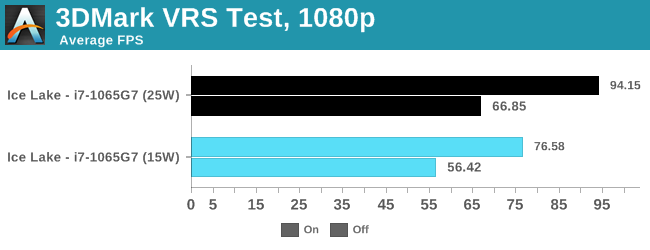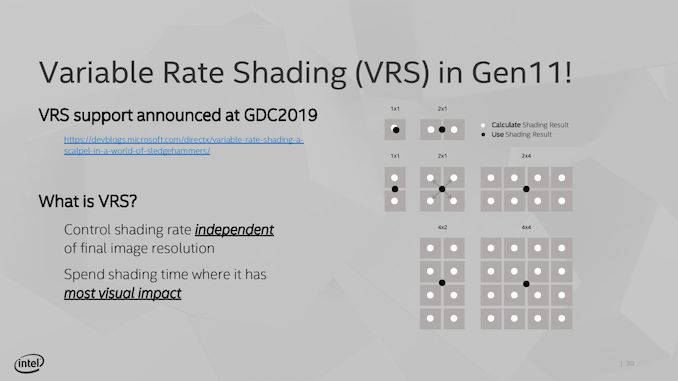The Ice Lake Benchmark Preview: Inside Intel's 10nm
by Dr. Ian Cutress on August 1, 2019 9:00 AM EST- Posted in
- CPUs
- Intel
- GPUs
- 10nm
- Core
- Ice Lake
- Cannon Lake
- Sunny Cove
- 10th Gen Core
Gaming Results (15W and 25W)
One of the biggest changes to the Ice Lake design is in the integrated graphics – Intel is now giving more focus and more die area to graphics, something it has arguably been neglecting for several years now. With Ice Lake, we move to a Gen11 graphics architecture, which is almost like the previous Gen9.5 but now with added support for variable rate shading (VRS), moving from 24 EUs to 64 EUs, and memory support up from LPDDR3-2133 to LPDDR4X-3733.


World of Tanks is a very CPU driven benchmark, and having the extra frequency of the 25W processor does help here. We're getting a sizeable uplift from Whiskey Lake, due to the extra EUs and memory frequency.


Our Final Fantasy test seemed to regress in 25W mode, although still within the noise. This test is still GPU bound, so adding the extra TDP to the CPU didn't actually help much. However, comparing to the Whiskey Lake integrated graphics, we've got over a 2x speedup.


Similarly with Civilization, with what is normally our 'IGP' settings, we are still GPU limited here.
One of Intel's newest features is Variable Rate Shading.
If developers add the option, soon to be an easy checkbox in Unity and Unreal, the game can decide to control the rate at which it shades pixels, from calculating every pixel down using one result across a 4x4 grid, to save compute power. Currently the only way to test this is with the 3DMark functional demo.

The new VRS test in 3DMark is designed as a feature test to show the potential uplift effect from enabling variable rate shading within a game. In both 15W and 25W modes, the data saw a good uplift, and we seemed to get more out of the 25W mode than the 15W mode.














261 Comments
View All Comments
Phynaz - Saturday, August 3, 2019 - link
You guessed wrong, but considering your education level that should be expectedKorguz - Saturday, August 3, 2019 - link
i did ?? sure seems like you only want quad cores still... my guess, yours is maybe grade 10.AntonErtl - Friday, August 2, 2019 - link
I am guessing that SPEC CPU2017 Rate-1 means one copy of the benchmark, so it also gives us single-thread performance (and that explains why the power limit differences do not play a bigger role). Right?One thing that I find remarkable about the recent AMD and Intel launches is that Intel follows the pattern (already seen with Broadwell) of starting a new process with a low clock, and therefore with mobile products and then servers. If they follow their earlier pattern, we will see higher-clocked stuff on 10nm in the future.
By contrast, AMD (and the smartphone SoC vendors) manage to get the same or better clock rates with the newer process as with the older ones.
From what I hear, Intel is very much into hand-tuning their CPUs (that's why backporting Ice Lake to 14nm would be very expensive in terms of both labor and time-to-market), while AMD and the smartphone SoC vendors rely on more automatic tools. What is interesting is that AMD managed to get within a few % of clock rate of a highly tuned Intel chip (with several years of tuning both the process and the layout of the chip) with this more automatic approach, while having a similar IPC.
Intel has been working on Ice Lake and 10nm for a while, and still suffer from a clock rate deficit compared to Whiskey Lake (but in a way, 10nm is just becoming usefully online now, so maybe we should start the clock now). The fact that they have increased the TDP of the Y SKUs and decreased the base clock of the 15W SKUs (from 1.9GHz for the 8665U to 1.3GHz for the 1065G7) indicates that they still have problems being competitive wrt power consumption under load with Whiskey Lake. It will be interesting to see the final products (and compare them to Whiskey Lake and Picasso products with similar power delivery and cooling).
Phynaz - Friday, August 2, 2019 - link
AMD pushes their overvolted chips to the very limit. Intel doesn’t have to.Korguz - Friday, August 2, 2019 - link
" Intel doesn’t have to. " um.. i guess you havent seen the articles about how much intels cpus really use then. 95 watts, up to 200 watts in realityPhynaz - Saturday, August 3, 2019 - link
Wow, you’re really, really dumb. Do you get state aid?Korguz - Saturday, August 3, 2019 - link
oh how so ?? AT even posted a write up on this, obviously, you havent read it. so you are the one that needs aid, as you are the dumb one here....Alexvrb - Monday, August 5, 2019 - link
Reading isn't Phynaz' strong suit. However when you state a fact he can't counter, he immediately switches to low brow personal attacks - those are really more his speed.mobutu - Friday, August 2, 2019 - link
It doesn't mattter (for me), this time I'll buy AMD.HStewart - Friday, August 2, 2019 - link
Then why comment if it doesn't matter to you.